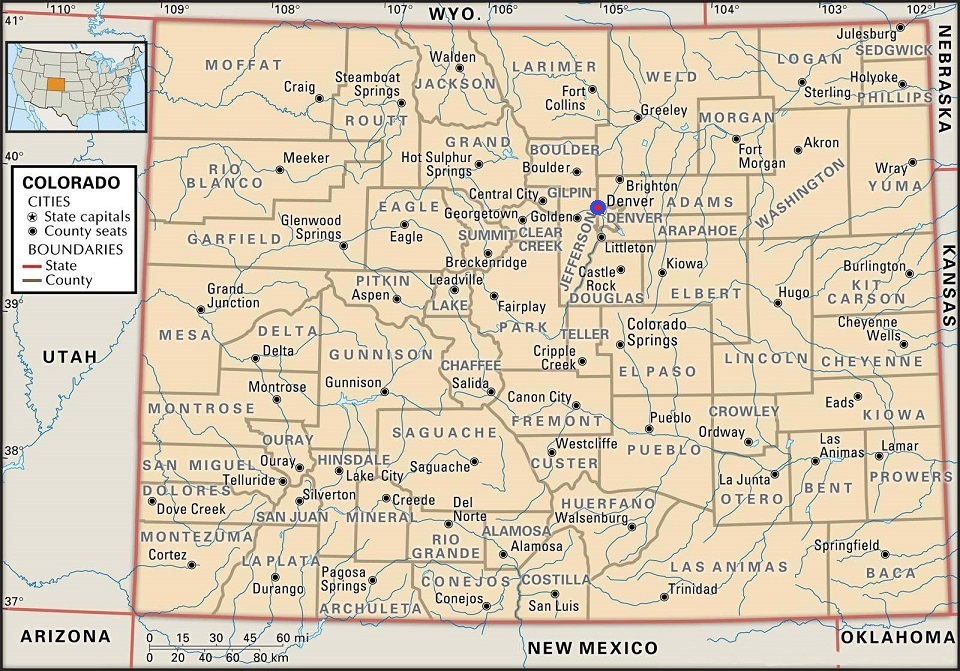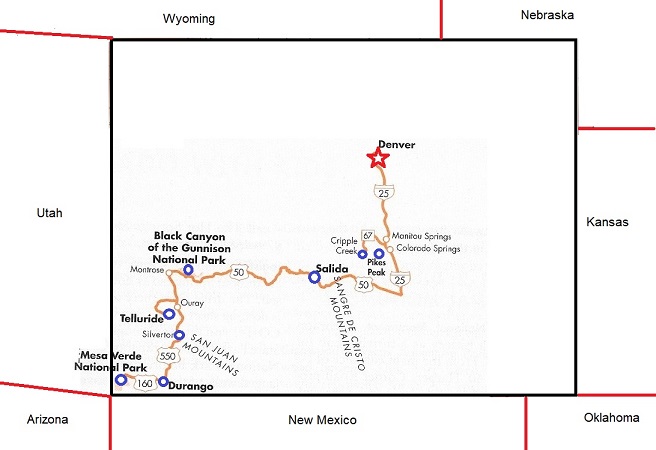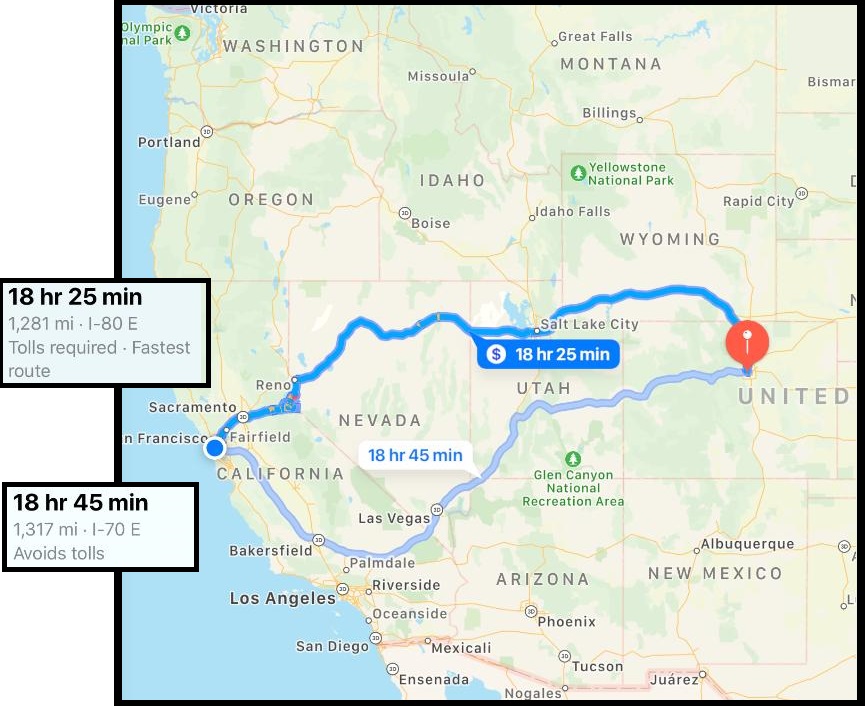 |

|

|
| Trip Planning | History of Colorado | Points of Interest | Colorado River | Overviews & Photos |
|
Trip Planning |
The photo on the left was taken on our first road trip in June of 2020 to visit Virginia's sister's Black Heron Inn located near the town of Point Reyes Station north of San Francisco.
We had a great three day stay and saw wild turkey, deer, Tule Elk and lots of birds! And especially interesting, the park with the fence that split and jumped almost 20 feet from the 1906 earthquake. The North American Plate is stationery but the Pacific Plate moved up to 20 feet north, pushing against the North American Plate as it moved north!
Virginia and I wanted to do a road trip again and perhaps go to Colorado as there is so much to see and do.
We are in the process of planning what to do and perhaps instead of driving from San Francisco, fly to Denver and rent a car. Then either drive back to the City or fly back from Denver.
This all depends on the situation as to traveling with the COVID-19 pandemic when flying or cruising on a ship.
| History of Colorado |
First explored by Europeans in the late 1500s (the Spanish referred to the region as “Colorado” for its red-colored earth), the area was ceded to the United States in 1848 with the Treaty of Guadalupe Hidalgo that ended the Mexican-American War (1846-48). In 1858, the discovery of gold in Colorado attracted new settlers.
During the Plains Indian Wars (1860s-80s), Colorado’s wild frontier was the scene of intense fighting between Native Americans and white settlers. In the 21st century, Colorado continues to rely on its natural resources as well as agriculture and tourism to sustain its economy.
Mesa Verde National Park contains more than 4,000 archaeological sites—including around 600 cliff dwellings—from the Ancestral Puebloans who inhabited the area from about AD 550 to 1300. By the late 13th century, they began to migrate south to New Mexico and Arizona, where their descendants continue to live today.
Discovered by Lieutenant Zebulon Pike in 1806 during an expedition to determine the southwestern boundary of the Louisiana Purchase, Pikes Peak became a landmark to the thousands of fortune hunters who traveled west with the slogan “Pikes Peak or Bust” on their wagons after gold was found in the area in 1858.
On November 29, 1864, more than 150 peaceful Cheyenne and Arapaho Indians—believing themselves to be under the protection of the U.S. government—were slaughtered by close to 700 Colorado volunteer soldiers under the command of Colonel John Chivington. The atrocity devastated the tribes and served as a catalyst for years of subsequent warfare between Native American Indians and the U.S. Army.
The lyrics to “America the Beautiful” were written by Katharine Lee Bates after an awe-inspiring trip to the top of Pikes Peak in 1893. Although it is now commonly sung to the tune “Materna,” composed by Samuel Ward in 1882, the patriotic poem was often sung to “Auld Lang Syne” in the early 20th century.
The Colorado Rockies are part of the North American Cordillera, which sweeps the western part of the continent all the way from Alaska into northern Mexico. With 58 named peaks over 14,000 feet and an average altitude of 6,800 feet, Colorado has the highest elevation of all the states.
The Colorado River is one of the principal rivers (along with the Rio Grande) in the Southwestern United States and northern Mexico. The 1,450-mile-long (2,330 km) river drains an
Known for its dramatic canyons, whitewater rapids, and eleven U.S. National Parks, the Colorado River and its tributaries are a vital source of water for 40 million people. The river and its tributaries are controlled by an extensive system of dams, reservoirs, and aqueducts, which in most years divert its entire flow for agricultural irrigation and domestic water supply. Its large flow and steep gradient are used for generating hydroelectric power, and its major dams regulate peaking power demands in much of the Intermountain West. Intensive water consumption has dried up the lower 100 miles (160 km) of the river, which has rarely reached the sea since the 1960s.
Large engineering works began around the start of the 20th century, with major guidelines established in a series of international and U.S. interstate treaties known as the "Law of the River". The U.S. federal government was the main driving force behind the construction of dams and aqueducts, although many state and local water agencies were also involved. Most of the major dams were built between 1910 and 1970; the system keystone, Hoover Dam, was completed in 1935.
The Colorado is now considered among the most controlled and litigated rivers in the world, with every drop of its water fully allocated. The environmental movement in the American Southwest has opposed the damming and diversion of the Colorado River system because of detrimental effects on the ecology and natural beauty of the river and its tributaries.
During the construction of Glen Canyon Dam, environmental organizations vowed to block any further development of the river, and a number of later dam and aqueduct proposals were defeated by citizen opposition. As demands for Colorado River water continue to rise, the level of human development and control of the river continues to generate controversy.
A ten day plus tour of many of the most impressive places to see in Colorado
The Southwestern region of Colorado includes the famous Indian cliff dwellings at Mesa Verde National Park and the famous Black Canyon of the Gunnison National Park and Pikes Peak. Don't forget we will be at the Four Conners where one can stand on four states at the same time! Colorado, New Mexico, Arizona and Utah!
As you can see, at the last stop is in Colorado at Mesa Verde National Park, it looks like we might drive through Utah on the way through Nevada and on to California and San Francisco!
As a tribute to the grandeur of the Rocky Mountains between Estes Park and Grand Lake, this park encompasses the pure and natural beauty of the region. With high-mountain lakes and streams, peaks more than 14,000 feet, thick evergreen forests and thousands of acres of wildlife, this national park conjures up what most people imagine when they think of the Rockies and finds its way onto most visitors’ travel itineraries. And with so much to see and do within its 415-square-mile boundaries there’s no wonder its popularity endures.
Mesa Verde National Park, located in southwest Colorado near Cortez, is home to some of the most unique Ancestral Puebloan dwellings in the world. Well-preserved and well-studied, these dwellings have been inspiring interest in this ancient culture for more than 100 years. Tucked securely into cliff walls, the adobe-constructed homes are a novel sight to visitors who crane their necks skyward to see them. On Mesa Verde tours, ladders give guided groups access to the cliff dwellings, and park rangers offer glimpses into the daily lives of Ancestral Puebloans.
One-hour walking tour of Cliff Palace, the largest cliff dwelling and home to multiple living enclaves and buildings. You can expect to do a bit of mild climbing and walking, as the route first descends roughly 100 feet over uneven steps and ascends a series of eight-foot ladders to access and exit the site.
3. Great Sand Dunes National Park and Preserve
Nowhere else in the United States do mountains of sand stand higher than in the Rocky Mountains at Great Sand Dunes National Park in Colorado. The tallest dune towers 750 feet high at an elevation of 8,700 feet above sea level. The entire dune field itself, located near the town of Alamosa, encompasses 30 square miles within the 150,000-acre park.
4. Black Canyon of the Gunnison National Park
Sheer black walls plummet up to 2,700 feet on this 53-mile stretch of narrow gorge near Montrose, which reveal millions of years of natural history. Since its documented European discovery in the 1700s, the gorge has been renowned for its dramatic scenery and recreational opportunities.
Not to mention its history: The Denver and Rio Grande narrow gauge railroad once traversed the mouth of this fissure that plunges into the Rockies. Today, the train is paid homage by an informative railroad museum and ranger talks throughout the park.
We could take one route on the way to Denver and the other route back for a different views on the road trip!
I also suggested we could fly to Denver and rent a car instead of taking two days of driving? Actually four days back and forth or even more depending on how hard it is to drive, maybe actually six days!
Day 01
View of San Francisco from Chuck's Apartment!
Day 2
xxx
xxx
Day 3
xxx
xxx
Colorado, which joined the union as the 38th state in 1876, is America’s eighth largest state in terms of land mass. Located in the Rocky Mountain region of the western United States, the state’s abundant and varied
 natural resources attracted the ancient Pueblo peoples and, later, the Plains Indians.
natural resources attracted the ancient Pueblo peoples and, later, the Plains Indians.
Points of Interest in Colorado
Interesting Facts about Colorado

Colorado River Over View
Interesting Facts about the Colorado River
 expansive, arid watershed that encompasses parts of seven U.S. states and two Mexican states. Starting in the central Rocky Mountains of Colorado, the river flows generally southwest across the Colorado Plateau and through the Grand Canyon before reaching Lake Mead on the Arizona–Nevada border, where it turns south toward the international border. After entering Mexico, the Colorado approaches the mostly dry Colorado River Delta at the tip of the Gulf of California between Baja California and Sonora.
expansive, arid watershed that encompasses parts of seven U.S. states and two Mexican states. Starting in the central Rocky Mountains of Colorado, the river flows generally southwest across the Colorado Plateau and through the Grand Canyon before reaching Lake Mead on the Arizona–Nevada border, where it turns south toward the international border. After entering Mexico, the Colorado approaches the mostly dry Colorado River Delta at the tip of the Gulf of California between Baja California and Sonora.
Four National Parks
1. Rocky Mountain National Park
 2. Mesa Verde National Park
2. Mesa Verde National Park
Driving to Denver from San Francisco
Two possible routes, one with tolls and one without. Not too much difference in driving times.

Driving from San Francisco to Denver Colorado or should we fly?

Colorado Verbiage
Over View of the Day


Colorado Verbiage
Over View of the Day


Created on: 2020.01.17

Updated on: 2021.03.22